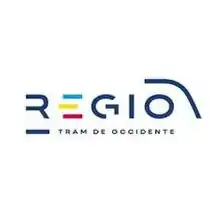RegioTram
The Train for the Vicinities of the City of Bogotá (Spanish: Tren de cercanías de Bogotá), also known as RegioTram, is a transportation project for of a mass and rapid transport system to connect Bogotá with surrounding cities. This transportation project is to replace the, now defunct, Bogotá Savannah Railway.
 | |
| Overview | |
|---|---|
| Owner | Gobernación de Cundinamarca - Bogotá D.C. |
| Area served | Bogotá savanna |
| Locale | Bogotá, Colombia |
| Transit type | Commuter rail/tram train |
| Number of stations | 17 |
| Operation | |
| Operation will start | 2024[1] |
| Operator(s) | China Civil Engineering Construction Corporation |
| Technical | |
| System length | 39.6 km (24.6 mi) |
| Track gauge | 1,435 mm (4 ft 8 1⁄2 in) standard gauge |
History
In February 2019, a Spanish consortium of Ardanuy Ingeniería and FGC was awarded a contract to provide project consultancy and supervision services for the first 41km tram-train line, designed to connect Bogota with the municipalities of Mosquera, Madrid, Funza, Sector El Corzo and Facatativá in the department of Cundinamarca. The line is forecast to carry 211,000 daily passengers, with 17 stations and an end-to-end journey time of 48 minutes.[2] By August that same year, tendering for the line was launched by the Colombian government with a projected 2024 opening.[1]
In 2019, Chinese company CCECC won a contract to build the regional train line to connect Bogota to its neighbouring suburbs, known as RegioTram.[3]
Planned lines
| Name | Opening date | Length | Number of stations | Notes | |
| 2024[1] | 36.9 km | 17 | Contracted.[4] | ||
| 48 km | 15 | In design.[5] | |||
| --- | --- | --- | In project |
RegioTram de Occidente
It indiscriminately designates two independent projects, of an analogous typology, to provide Bogotá and its surroundings with a fast, ecological, safe and integrated means of transport in the urban area that provides the user with a transport alternative to the traditional public transport systems existing in the shape of a train-tram. The system will be made up of two lines or corridors between the Calle 26 Station of the Bogotá Metro and Facatativá that have a potential of 150 million trips. The project is a railway system that in urban areas works with more frequent stations with a maximum of 60 kilometers per hour and in interurban ones it reaches 100 kilometers per hour.
In the inter-urban sections, it acts as a commuter train with speeds of up to 100 kilometers per hour and that also runs in the urban environment in a light rail format, allowing integration into the city's fabric and shortening the duration of the trip, by avoid modal exchanges.
The proposal has been made in the form of a Public Private Association (APP), through which a company or private consortium makes a proposal based on previous feasibility studies (prefeasibility) regarding an infrastructure project, for its subsequent implementation. up and running.
Characteristics
Light electric vehicle with double functionality.
It would have stations located from 500 meters away in the urban sections, up to 5 kilometers in the interurban ones. It would have a high security access system, with automatic doors to the trains, synchronized with their arrival. It would be controlled by a central command post and completed with garages and workshops for train maintenance.9
The project, which will be 39.6 kilometers in length and 17 stations in various municipalities in Bogotá (Facatativá, Madrid, Mosquera, Funza) and three towns in western Bogotá. Enter Bogotá by Catam, arriving on Calle 26 in the railway corridor, that will allow mobilizing 44 million a year that among other things will transfer with the Bogotá Metro. In fact, it is recorded that in this first phase there will be 130,000 people mobilized per day.
The award was made on December 23, 2019 in the administration of the Governor of Cundinamarca, Jorge Emilio Rey, who spoke about the new Regiotram train from the West and the Chinese company to which the China Civil Engineering Construction Corporation (CCECC) consortium was awarded. going to build. The contract for this project was signed on January 7, 2020, and then the purchase of land, pre-construction, the transfer of networks, licenses, topography review will begin. Three and a half years of construction, in 2024 it will be in operation.
RegioTram del Norte
In August 2019, feasibility studies for the Northern Regiotram were announced, studies that would be financed by the Prosperity Fund of the United Kingdom and the Government of Cundinamarca, supported by an agreement with Findeter. In May 2020, the feasibility and legal and financial structuring of the project were signed.
References
- "Tendering begins for Bogota RegioTram West concession". International Railway Journal. 23 August 2019. Retrieved 23 August 2019.
- "Consultancy contract awarded for Bogota RegioTram project". International Railway Journal. 4 February 2019. Retrieved 29 April 2019.
- https://www.eltiempo.com/bogota/regiotram-de-occidente-lo-adjudican-a-empresa-china-pese-a-polemica-446388
- "Acta de inicio de obras del tren entre Bogotá y Cundinamarca fue firmada". 2020-06-24.
- "SITP, Sistema de Transporte Urbano de Bogotá".
External links
- Tren de cercanías - Instituto de Desarrollo Urbano de Bogotá
- Tren de Cercanías de la Sabana de Bogotá - Study of the project
- Tren de Cercanías será una realidad en el 2011: Samuel Moreno, retrieved on November 4, 2008.